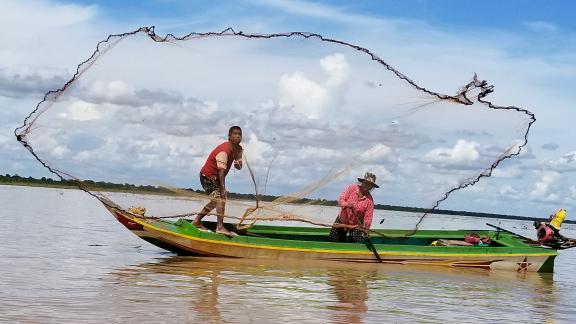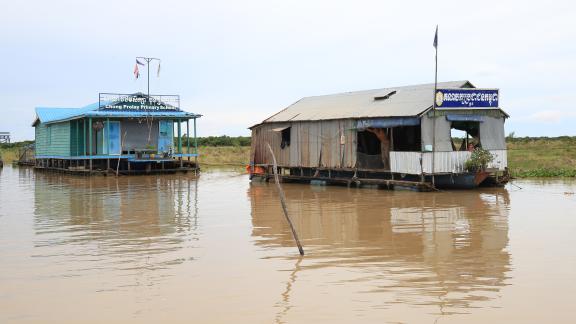By Chris Hufstader
Near Cambodia’s Tonle Sap Lake, a water purification system is helping people struggling to adapt to higher temperatures, lower water levels, and fewer fish.
Outside the primary school in Kampong Khleang, on the western edge of the Tonle Sap Lake, Riem Monisilong shows visitors how he purifies water from a nearby pond. He pipes the water into a series of tanks, filtering it through charcoal and sand, and then he runs it through a steel tube where a jolt of ultraviolet light kills any remaining bacteria.
Riem is 37 and is known to his friends as “Silong.” At work he wears protective equipment: a face mask and hair net, a gown, right down to gloves and rubber boots. He fills reusable 20-liter plastic bottles with the purified water, and seals them. They sell between 150 and 400 containers every month for about 45 cents each. They provide them for free to elderly people, schools, and people living with disabilities.
A reliable source of clean water, tested regularly and available for a modest cost, helps many here who are facing financial pressures and an uncertain future. Around 80 percent of the communities around the Tonle Sap Lake do not have a source of safe drinking water, and two-thirds of these communities consume water from unsafe sources. In addition, the fishing community in Kampong Khleang, like many others on the lake, is suffering from a declining fish population due in part to the effects of climate change and inconsistent rainfall, as well as deforestation and pollution.
Silong, who years ago suffered breathing problems related to toxic fumes from burning garbage (a common way of disposing of waste), takes the health challenges in his community personally. “I want the community to have clean water,” he says. “Working on the project aligns with my goal to help people have better health.”

Lack of water, partly due to changing rainfall patterns related to climate change, is affecting the ability of fishing families on Tonle Sap Lake to support themselves. Photo by Banung Ou for Oxfam
Adapting to a changing climate
The water purification system at Kampong Khleang was installed by Teuk Saat 1001, a Cambodia organization that is part of a comprehensive project undertaken by Oxfam and the Fisheries Action Coalition Team (FACT) to help families adapt to climate change, and protect and improve the environment. They have installed three water purification systems that are serving more than 1,600 families (about 7,000 people). Oxfam and the Wetlands Work Company are also providing eco-friendly toilets for homes and schools in nearby “floating villages” to cut down on sewage flowing directly into the lake.
FACT and Oxfam are helping communities to create eco-tourism and handicraft businesses as alternative livelihoods for fishing families. People are learning to run restaurants, drive tour boats, and host visitors in their homes. This helps families diversify their sources of income, reduces the pressures on the fishery resource, and spreads awareness of the sensitive environment around the Tonle Sap Lake.
FACT provides training and funds to support fishery committees charged with monitoring fishing areas for violations of regulations and raising awareness of the harms caused by illegal fishing methods. The project is also helping communities to reduce plastic and other garbage from going into rivers and lakes.
Tonle Sap is the largest freshwater lake in southeast Asia and produces 60 percent of Cambodia’s freshwater fish. In the rainy season, Tonle Sap expands like a bladder, inundating nearby forests where fish breed. Between the changing climate, fluctuations in rainfall and water flow due to dams in the Mekong River (a major contributor of water and fish to Tonle Sap), and recent changes in government regulations that limit how much fish people can catch, families are having a tough time making ends meet. One fisherman from Kampong Khleang reports that 10 years ago, “in 24 hours we would get 50 kilos [110 pounds] of fish.” Now, he says, “we get about five kilos.”

Riem Monisilong installed two eco-friendly toilets in this floating school near Kampong Khleang. The toilet systems process waste on-site and are part of the effort to reduce raw sewage entering the lake. Photo: Banung Ou/Oxfam
Aware of the environment
Oxfam’s collaboration with FACT and Teuk Saat 1001 in communities around the western part of Tonle Sap Lake relies on mobilizing visionary community members like Riem Monisilong to join in the effort to help families diversify their income and protect the environment. In every community, they form and support committees to manage the community fishery, eco-tourism and handicraft training, youth groups for raising awareness about the environment and replanting trees, and people like Silong to purify and sell clean water.
In addition to running the water purification system in Kampong Khleang, Silong also installs toilets in floating homes and schools. The toilet system treats sewage on site through a series of four digester tanks where bacteria breaks down the waste. He installed two at the Chong Prolay primary school, a one-room floating school house at the mouth of the river flowing into Tonle Sap Lake.
He’s also an artist who specializes in using discarded plastic waste and trash, and has several pieces at the water purification plant in front of the school. “My message to the next generation is to fight climate change and don’t throw your waste everywhere,” he says.
He works full time purifying water and installing toilets because “My art does not make much profit, but it comes from my heart with love,” he says.
This effort is part of the project Fisher Folks Making Circular Economy Work for the Western Tonle Sap Lake (FOSTER) funded by the European Union.
The story was published on Oxfam Impact 2022.
